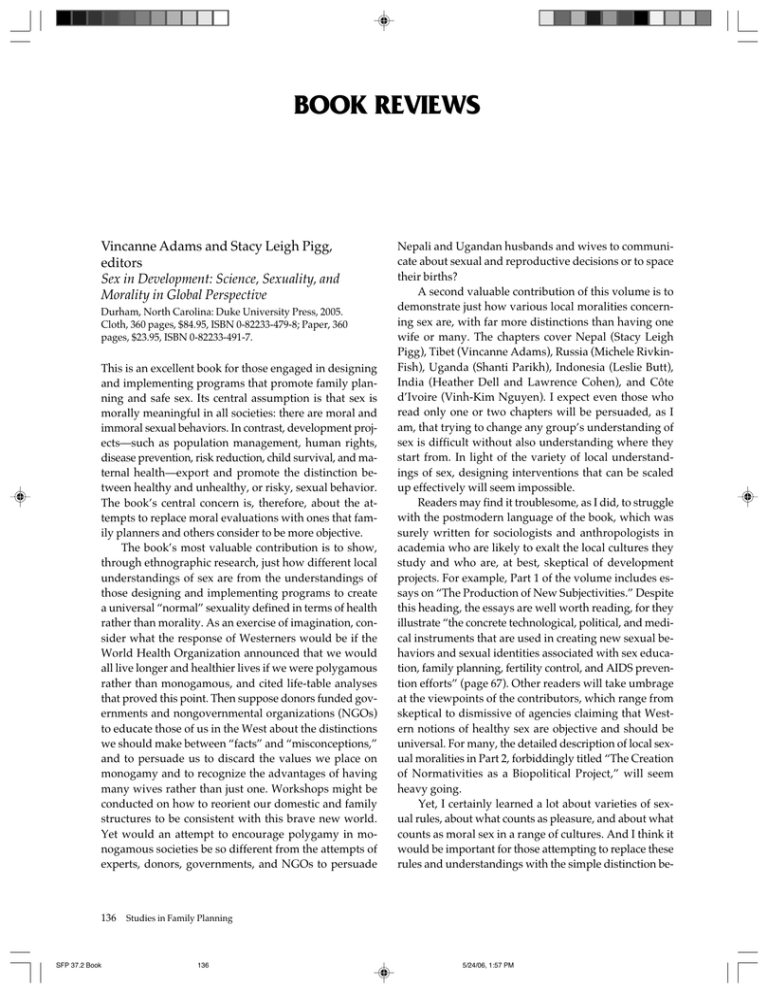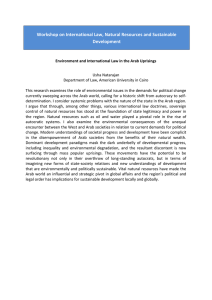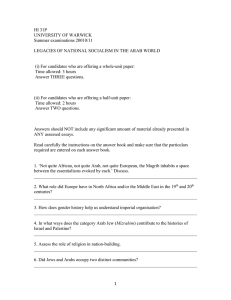
BOOK REVIEWS
Vincanne Adams and Stacy Leigh Pigg,
editors
Sex in Development: Science, Sexuality, and
Morality in Global Perspective
Durham, North Carolina: Duke University Press, 2005.
Cloth, 360 pages, $84.95, ISBN 0-82233-479-8; Paper, 360
pages, $23.95, ISBN 0-82233-491-7.
This is an excellent book for those engaged in designing
and implementing programs that promote family planning and safe sex. Its central assumption is that sex is
morally meaningful in all societies: there are moral and
immoral sexual behaviors. In contrast, development projects—such as population management, human rights,
disease prevention, risk reduction, child survival, and maternal health—export and promote the distinction between healthy and unhealthy, or risky, sexual behavior.
The book’s central concern is, therefore, about the attempts to replace moral evaluations with ones that family planners and others consider to be more objective.
The book’s most valuable contribution is to show,
through ethnographic research, just how different local
understandings of sex are from the understandings of
those designing and implementing programs to create
a universal “normal” sexuality defined in terms of health
rather than morality. As an exercise of imagination, consider what the response of Westerners would be if the
World Health Organization announced that we would
all live longer and healthier lives if we were polygamous
rather than monogamous, and cited life-table analyses
that proved this point. Then suppose donors funded governments and nongovernmental organizations (NGOs)
to educate those of us in the West about the distinctions
we should make between “facts” and “misconceptions,”
and to persuade us to discard the values we place on
monogamy and to recognize the advantages of having
many wives rather than just one. Workshops might be
conducted on how to reorient our domestic and family
structures to be consistent with this brave new world.
Yet would an attempt to encourage polygamy in monogamous societies be so different from the attempts of
experts, donors, governments, and NGOs to persuade
136
SFP 37.2 Book
Nepali and Ugandan husbands and wives to communicate about sexual and reproductive decisions or to space
their births?
A second valuable contribution of this volume is to
demonstrate just how various local moralities concerning sex are, with far more distinctions than having one
wife or many. The chapters cover Nepal (Stacy Leigh
Pigg), Tibet (Vincanne Adams), Russia (Michele RivkinFish), Uganda (Shanti Parikh), Indonesia (Leslie Butt),
India (Heather Dell and Lawrence Cohen), and Côte
d’Ivoire (Vinh-Kim Nguyen). I expect even those who
read only one or two chapters will be persuaded, as I
am, that trying to change any group’s understanding of
sex is difficult without also understanding where they
start from. In light of the variety of local understandings of sex, designing interventions that can be scaled
up effectively will seem impossible.
Readers may find it troublesome, as I did, to struggle
with the postmodern language of the book, which was
surely written for sociologists and anthropologists in
academia who are likely to exalt the local cultures they
study and who are, at best, skeptical of development
projects. For example, Part 1 of the volume includes essays on “The Production of New Subjectivities.” Despite
this heading, the essays are well worth reading, for they
illustrate “the concrete technological, political, and medical instruments that are used in creating new sexual behaviors and sexual identities associated with sex education, family planning, fertility control, and AIDS prevention efforts” (page 67). Other readers will take umbrage
at the viewpoints of the contributors, which range from
skeptical to dismissive of agencies claiming that Western notions of healthy sex are objective and should be
universal. For many, the detailed description of local sexual moralities in Part 2, forbiddingly titled “The Creation
of Normativities as a Biopolitical Project,” will seem
heavy going.
Yet, I certainly learned a lot about varieties of sexual rules, about what counts as pleasure, and about what
counts as moral sex in a range of cultures. And I think it
would be important for those attempting to replace these
rules and understandings with the simple distinction be-
Studies in Family Planning
136
5/24/06, 1:57 PM
tween healthy and unhealthy sexual behavior to have the
sort of deep ethnographic knowledge that this volume
provides. An obvious practical implication is that intervention projects should include sophisticated ethnographers such as the contributors to this volume—although
the intervention community is unlikely to want to spend
the money and time that this approach would require.
Simply having a local partner to provide a gloss of “cultural sensitivity” is not enough, however. In my experience, urban elites either do not know enough or are unwilling to say, preferring rather to adopt the “healthy–
unhealthy sex” rhetoric of the donors and NGOs.
Ultimately, the cumulation of chapters in this volume make overwhelmingly clear that we need to pay
more attention to our own cultural constructions of
sexual behavior as well as the cultural ground on which
our attempts to export them fall.
Susan Cotts Watkins
Visiting Research Scientist
California Center for Population Research
University of California, Los Angeles, and
Professor, Department of Sociology
Population Studies Center
University of Pennsylvania, Philadelphia
Ruth Levine and the What Works Working
Group of the Center for Global Development
Millions Saved: Proven Successes in Global Health
Washington, DC: Center for Global Development, 2004.
Paper, 167 pages, $26.95, ISBN 0-88132-372-1.
The volume Millions Saved: Proven Successes in Global
Health presents 17 case studies of program success in the
areas of reproductive, adult, and child health in developing countries. An introductory overview extracts useful lessons from these past successes for developing
country and global health policy. Convened by the Center for Global Development’s Global Health Policy Research Network as the “What Works Working Group,”
the task force for this project was comprised of a distinguished international team of 15 scientists, policymakers, and health innovators who are acknowledged experts
in international health development.
The review includes successful global campaigns,
such as the global program to eradicate smallpox; successful regional initiatives, such as the eradication of polio and the control of Chagas disease in Latin America,
and measles vaccination, guinea worm reduction, and
onchocerciasis (river blindness) control in Southern Af-
rica; and successful national campaigns, such as the promotion of diarrheal management in Egypt and tuberculosis control in China. National success stories in chronic
disease prevention are also reviewed—case studies of tobacco-consumption reduction in Poland, iodine-deficiency
reduction in China, and the prevention of dental caries
in Jamaica. Three cases concern reproductive health: the
role of the national family planning program in the Bangladesh fertility transition, the promotion of safe motherhood in Sri Lanka, and the successful national campaign to prevent the spread of HIV infection in Thailand.
The volume contains one comparative review, a discussion of successful meningitis-vaccination campaigns in
Chile and The Gambia. Thus, 16 of the cases review specific health-service interventions. One review discusses
elements of a successful approach to reaching Mexico’s
poor with a package of basic health services.
Perhaps as a consequence of its emphasis on specific campaigns and illnesses, the volume demonstrates
the value of charismatic leadership, organizational focus,
political commitment, and special resources for achieving impact. For example, the chapter on smallpox eradication outlines the feasibility of responding to the complex organizational challenge of canvassing the rural and
remote populations in impoverished settings. Sound
leadership combined with the effective use of evidencebased planning produced dramatic results. Although
eradication campaigns are sometimes criticized as a costly distraction for poor countries, cost analyses discussed
in the chapter establish the potential long-term economic
benefits of eradication efforts, lending support to contemporary investment in the global polio-eradication
campaign. The smallpox chapter and chapters on successful vaccination campaigns against polio and measles
provide useful historical grounding for the investments
that have recently been directed to the Global Alliance
for Vaccines and Immunization.
Despite these important contributions, one significant limitation of the book is its focus on successful campaigns rather than successful strategies for developing
health-care systems. Although the need for effective delivery systems is acknowledged in the summary chapter, these studies emphasize the elements of successful
vertical program success rather than examples of how
integrated health-service systems can be developed and
sustained successfully. The volume will be of limited
value to developing-country health planners charged
with the task of developing health-sector reform. Case
studies of health-sector reform would demonstrate ways
to develop integrated systems of care, feasible means of
scaling up pilot projects, examples of sector-wide healthcare financial planning, strategies for developing serv-
Volume 37 Number 2 June 2006
SFP 37.2 Book
137
5/24/06, 1:57 PM
137
ice quality, means of decentralizing management and
of building community involvement, and other themes
of national health-sector reform.
The review is, nonetheless, a valuable resource for
the international health-policy community. Conclusions
emerge from the case studies that are directly relevant
to building consensus for actions that solve the health
problems affecting the world’s poor. All case studies in
the review demonstrate that success is possible, even in
challenging circumstances. Several case studies demonstrate that a major impact can be achieved at low cost.
All case studies are based on solid evidence, demonstrating the policy value of research. The reviews document
examples of successful public effort, addressing the common misperception that public-sector programs cannot
work. Principles of international partnership are documented, demonstrating that local initiative and investment can succeed even in constrained resource settings,
particularly if action is supported by catalytic investment
from the international community. The volume provides
solid evidence that millions of lives have been saved by
the introduction of curative and preventive health services. Its conclusions suggest that millions more could
be saved if the report’s recommendations for consensus
and investment were adopted by the global development community.
James F. Phillips
Senior Associate
Policy Research Division
Population Council
Onn Winckler
Arab Political Demography, Volume One:
Population Growth and Natalist Policies
Brighton, UK: Sussex Academic Press, 2005. 272 pages. Cloth,
$75, ISBN 1-902210-70-0; paper, $40, ISBN 1-902210-71-9.
Arab Political Demography, Volume One examines the evolution of population policies in the Arab World in light
of demographic developments in the past half-century.
It focuses on political influences, on demographic policies, and in particular, on the evolution from pronatalist
policies in effect during the 1950s, ‘60s, and ‘70s to
antinatalist or neutral policies adopted in the decades
following the end of the October 1973 oil boom.
Chapter 1 provides a brief review of the quantity and
quality of demographic data available for several Arab
countries. It points out the paucity of demographic data
available for many of the countries covered and highlights
138
SFP 37.2 Book
the particular dearth of data concerning ethnoreligious
composition. The author attempts to provide estimates
of the sizes of the ethnic populations of various Arab
countries, but these estimates appear to be highly speculative. In addition, the discussion of sources of employment and unemployment data is outdated. Considerably
more data are now available on these topics than are presented in this chapter.
Chapter 2 provides a primer on demographic transition theory and its application to the Arab world. It lays
out a long list of reasons for traditionally high fertility
rates in Arab countries, most of which are generic and
apply to any part of the developing world. Little specific information is provided to explain how these factors operate differently in Arab countries compared with
the rest of the world, and the author makes no attempt
to determine their relative contribution to high fertility
in Arab societies. The list of factors accounting for fertility declines since 1980 is equally generic and backed up,
for the most part, by sketchy or anecdotal information
about the specific situation of Arab countries. Incidentally, the author states that child labor is increasing in
countries such as Egypt, Jordan, Lebanon, Morocco, Syria, Tunisia, and Yemen on the basis of doubtful information drawn from a popular magazine. This information is refuted by findings from a number of other studies
of child labor conducted in these countries.
Chapter 3 presents an analysis of the emergence of
the employment problem in the Arab world as a preamble to a discussion of changes in population policies
in these countries. The author argues that pronatalist
policies in the 1960s and ‘70s were driven in part by a
perception of labor shortages in many countries of the
region, including both the sparsely populated oil states
and the nonoil states such as Jordan and Syria. By implication, the emergence of a structural unemployment
problem in these countries after the oil boom led to the
adoption of policies more favorable to limiting population growth. Although this argument appears plausible
at face value, it is too simple. The inability of the oil-rich
states to absorb the growing number of young nationals into their labor markets has less to do with overpopulation than with institutional factors that have rendered
these countries’ labor markets dependent upon cheap
foreign labor. By using public-sector employment as the
chief mechanism for redistributing their oil-wealth to nationals, the Gulf states have raised wage expectations of
nationals far higher than what employers in the private
sector are willing to pay. This change has put intense
pressure on these countries’ governments to maintain
the flow of foreign workers. Thus, the problem being described in the first instance is institutional rather than
Studies in Family Planning
138
5/24/06, 1:57 PM
demographic. In the populous nonoil states, recognition
of growing demographic pressures on the labor market
predates the oil boom, although, as the author notes, the
intensity of the governments’ efforts to do something
about this situation may have diminished during the
boom years.
Chapter 4, the core of the book, tackles explicitly the
issue of population policies of the Arab countries. The
author documents the pronatalist policies of the 1950s
and ‘60s while noting early experimentation with family
planning in Egypt in the 1950s and the adoption of national family planning programs in Egypt, Morocco, and
Tunisia in the mid-1960s. Although attitudes about the
danger to national development posed by rapid population growth were beginning to change in the 1970s, Arab
governments generally preferred an indirect approach
to fertility decline to direct governmental antinatalist
measures. They promoted socioeconomic development
by means of uncontroversial measures such as women’s
education and employment, with the hope that such
measures would lead to fertility decline. Only in the
mid-1980s did most of the countries in the region begin
to adopt explicit antinatalist measures by implementing
national family planning programs.
Although this volume makes a valuable contribution to the Arab population policy literature by tracing
the evolution of population policies in the Arab countries and by describing the factors that led to changes in
these policies, the book suffers from a number of shortcomings. The introduction begins with a discussion of
the growing gap between rich and poor Arab states and
the reasons for this gap. Unfortunately, this analysis of
growing differentiation and heterogeneity is not elaborated upon effectively in the rest of the book. Subsequent
chapters intermittently distinguish between the overpopulated Arab countries and the rich Arab oil states of
the Gulf Cooperation Council, but this distinction fails
to capture the extent of heterogeneity of population policies in the Arab World. The book includes little discussion of the situation of impoverished countries such as
Sudan and Yemen, where demographic trajectories differ greatly from those of more populous Arab countries.
Much of the analysis in Chapters 1, 2, and 3 relies on
substandard evidence that includes numerous references
to popular journalism. Throughout the book, the author
tends to list many factors in an attempt to account for a
particular phenomenon, such as high fertility or the
adoption of antinatalist population policies in the mid1980s, while omitting an explanation of the relative importance of each factor and its specific role in the outcome being described.
Ragui Assaad
Regional Director, West Asia and North Africa
Population Council
Cairo, Egypt
Volume 37 Number 2 June 2006
SFP 37.2 Book
139
5/24/06, 1:57 PM
139




